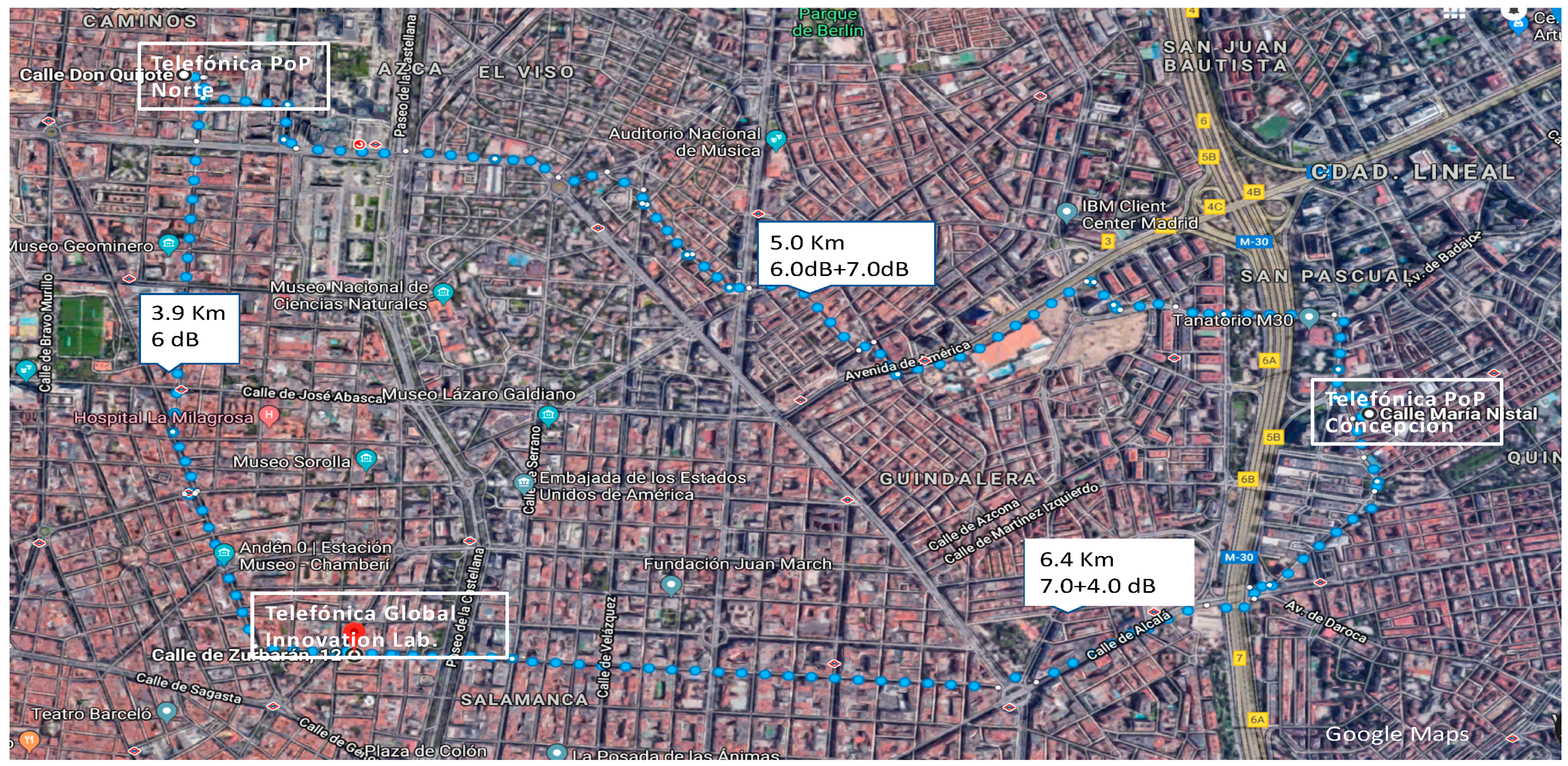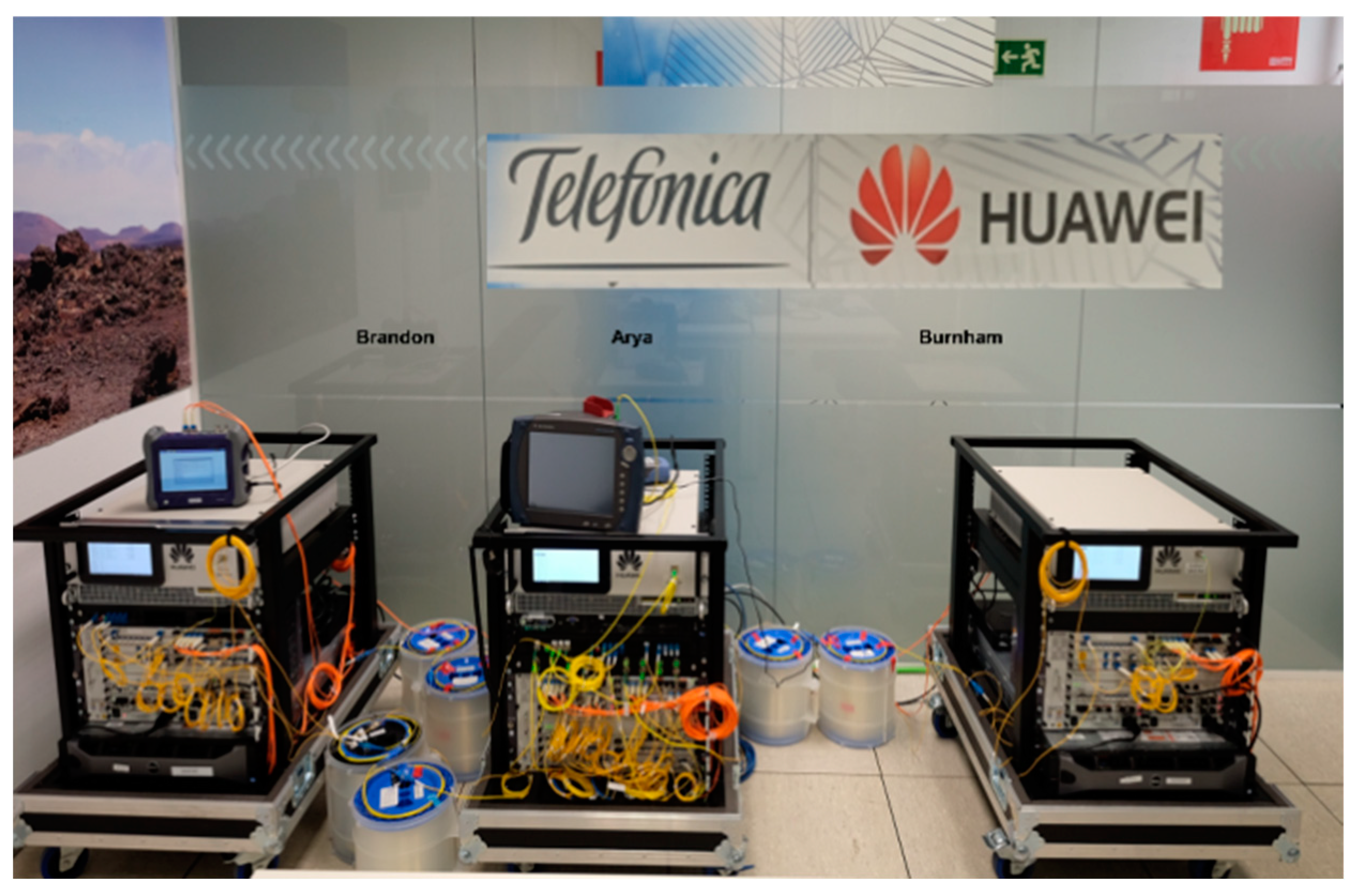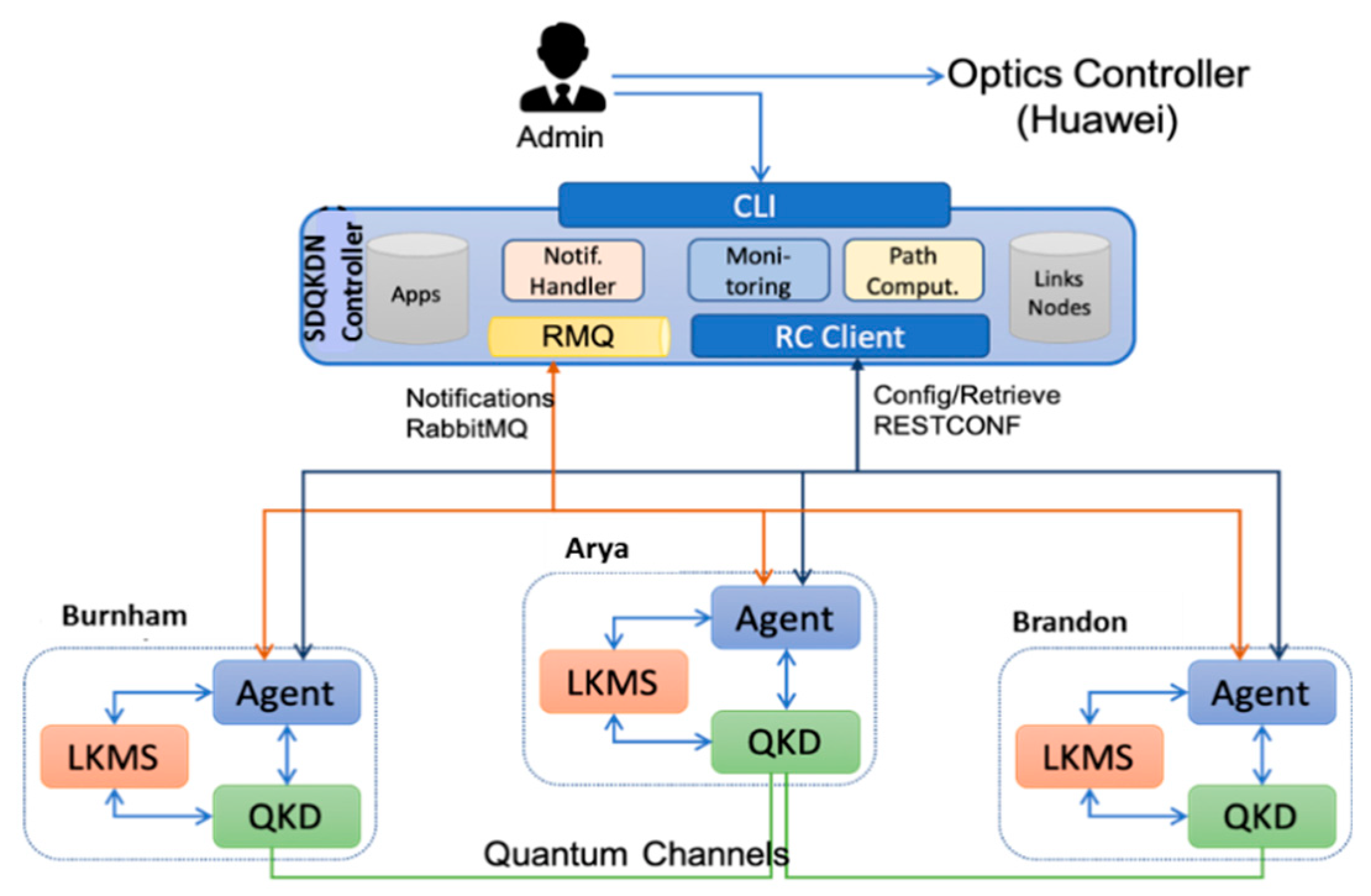Demonstration of Software Defined Network Services Utilizing Quantum Key Distribution Fully Integrated with Standard Telecommunication Network
Abstract
1. Introduction
2. Materials and Methods
3. Results
3.1. The QKD Devices Developed by HWDU
3.2. SDN Implementation
4. Discussion
5. Conclusions
Author Contributions
Funding
Conflicts of Interest
References
- Scarani, V.; Bechmann-Pasquinucci, H.; Cerf, N.J.; Dušek, M.; Lütkenhaus, N.; Peev, M. The security of practical quantum key distribution. Rev. Mod. Phys. 2009, 81, 1301. [Google Scholar] [CrossRef]
- Pirandola, S.; Andersen, U.; Banchi, L.; Berta, M.; Bunandar, D.; Colbeck, R.; Englund, D.; Gehring, T.; Lupo, C.; Ottaviani, C.; et al. Advances in Quantum Cryptography. Available online: https://www.osapublishing.org/aop/abstract.cfm?doi=10.1364/AOP.361502 (accessed on 18 July 2020).
- See e.g., QSC Workshops by ETSI. Available online: https://www.etsi.org/technologies/quantum-safe-cryptography (accessed on 18 July 2020).
- Briegel, H.-J.; Dür, W.; Cirac, J.I.; Zoller, P. Quantum Repeaters: The Role of Imperfect Local Operations in Quantum Communication. Phys. Rev. Lett. 1998, 81, 5932. [Google Scholar] [CrossRef]
- Peev, M.; Pacher, C.; Alléaume, R.; Barreiro, C. The SECOQC quantum key distribution network in Vienna. New J. Phys. 2009, 11, 075001. [Google Scholar] [CrossRef]
- Sasaki, M.; Fujiwara, M.; Ishizuka, H.; Klaus, W.; Wakui, K.; Takeoka, M.; Tanaka, A.; Yoshino, K.; Nambu, Y.; Takahashi, S.; et al. Field test of quantum key distribution in the Tokyo QKD Network. Opt. Express 2011, 19, 10387. [Google Scholar] [CrossRef] [PubMed]
- Wang, T.; Huang, P.; Zhou, Y.M.; Liu, W.Q.; Ma, H.X.; Wang, S.Y.; Zeng, G.H. High key rate continuous-variable quantum key distribution with a real local oscillator. Opt. Express 2018, 26, 2794. [Google Scholar] [CrossRef] [PubMed]
- Aguado, A.; Lopez, V.; Martinez-Mateo, J.; Szyrkowiec, T.; Autenrieth, A.; Peev, M.; Lopez, D.; Martin, V. Hybrid Conventional and Quantum Security for Software Defined and Virtualized Networks. JOCN 2017, 9, 819. [Google Scholar] [CrossRef]
- Aguado, A.; Lopez, V.; Lopez, D.; Peev, M.; Poppe, A.; Pastor, A.; Folgue, J.; Martin, V. The Engineering of a SDN Quantum Key Distribution Network. IEEE Commun. Mag. 2019, 57, 20–26. [Google Scholar] [CrossRef]
- Aguado, A.; López, V.; Brito, J.P.; Pastor, A.; López, D.R.; Martin, V. Quantum cryptography networks in support of path verification in service function chains. IEEE/OSA J. Opt. Commun. Netw. 2020, 12, B9–B19. [Google Scholar] [CrossRef]



© 2020 by the authors. Licensee MDPI, Basel, Switzerland. This article is an open access article distributed under the terms and conditions of the Creative Commons Attribution (CC BY) license (http://creativecommons.org/licenses/by/4.0/).
Share and Cite
Lopez, D.R.; Martin, V.; Lopez, V.; de la Iglesia, F.; Pastor, A.; Brunner, H.; Aguado, A.; Bettelli, S.; Fung, F.; Hillerkuss, D.; et al. Demonstration of Software Defined Network Services Utilizing Quantum Key Distribution Fully Integrated with Standard Telecommunication Network. Quantum Rep. 2020, 2, 453-458. https://doi.org/10.3390/quantum2030032
Lopez DR, Martin V, Lopez V, de la Iglesia F, Pastor A, Brunner H, Aguado A, Bettelli S, Fung F, Hillerkuss D, et al. Demonstration of Software Defined Network Services Utilizing Quantum Key Distribution Fully Integrated with Standard Telecommunication Network. Quantum Reports. 2020; 2(3):453-458. https://doi.org/10.3390/quantum2030032
Chicago/Turabian StyleLopez, Diego R., Vicente Martin, Victor Lopez, Fernando de la Iglesia, Antonio Pastor, Hans Brunner, Alejandro Aguado, Stefano Bettelli, Fred Fung, David Hillerkuss, and et al. 2020. "Demonstration of Software Defined Network Services Utilizing Quantum Key Distribution Fully Integrated with Standard Telecommunication Network" Quantum Reports 2, no. 3: 453-458. https://doi.org/10.3390/quantum2030032
APA StyleLopez, D. R., Martin, V., Lopez, V., de la Iglesia, F., Pastor, A., Brunner, H., Aguado, A., Bettelli, S., Fung, F., Hillerkuss, D., Comandar, L., Wang, D., Poppe, A., Brito, J. P., Salas, P. J., & Peev, M. (2020). Demonstration of Software Defined Network Services Utilizing Quantum Key Distribution Fully Integrated with Standard Telecommunication Network. Quantum Reports, 2(3), 453-458. https://doi.org/10.3390/quantum2030032








